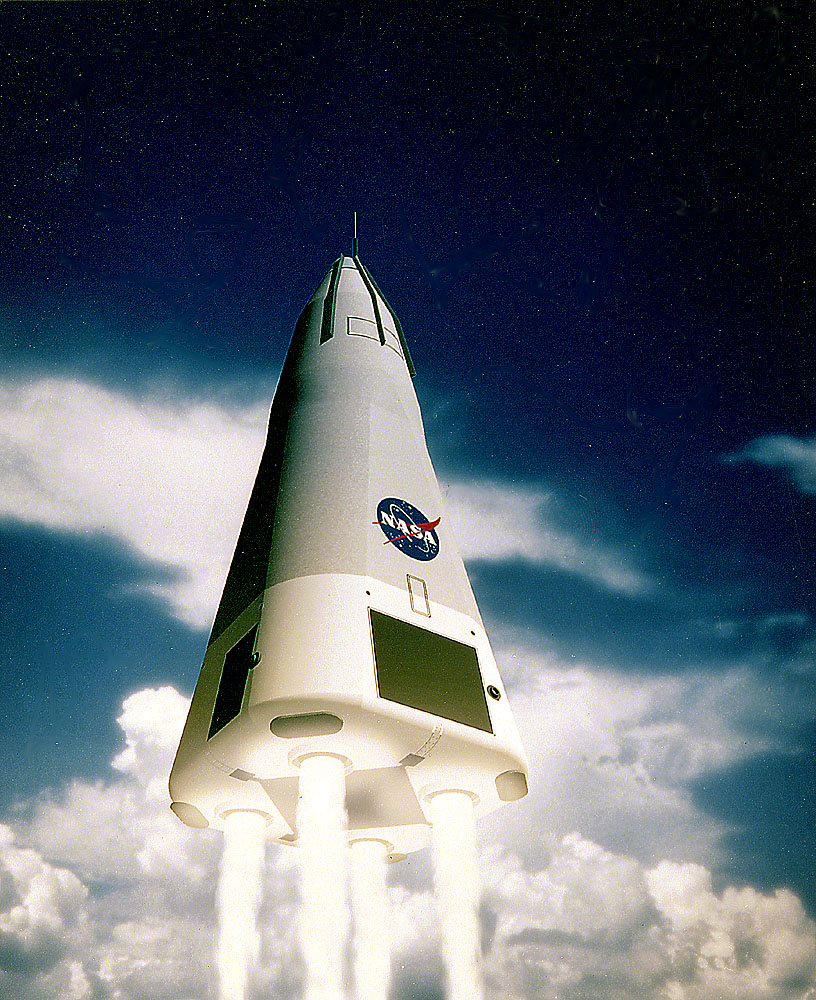On August 17, 2013, the DC-X/XA Team became the first team to be inducted into the International Space Hall of Fame. A Team Member Induction criteria was created to determine who the core members of the DC-X/XA Team were that should be included. Inductees were chosen who actively participated in the DC-X project, as part of a core team that made significant contributions to the program, during any one or all of the following three phases: 1) the SDIO phase from design to flight; 2) the DC-X flight campaign; or 3) the NASA technology demonstrator DC-XA program. Each member of the DC-X/XA Team displayed the qualities required to be inducted into the International Space Hall of Fame: imagination, achievement, and the dedication to further advance man’s knowledge of the universe, and his ability to explore and develop space for the benefit of all mankind.
A remarkable vehicle, the DC-X was touted at the time as bringing America to the “threshold of a new era in space”, making space available to the general public for business or pleasure. It demonstrated that a single stage to orbit vertical launch, vertical landing craft which could deliver a payload to low earth orbit, could be routinely and safely operated like an airplane and at one-tenth the cost of conventional expendable launch vehicles or the Space Shuttle. Such a spaceplane could also safely deliver people and freight to the other side of the world in under an hour. With famed astronaut and space visionary Pete Conrad as the Flight Commander, a small dedicated group of government and industry engineers and program managers, sustained by avid supporters, were about to make aerospace history.
The first flight of the DC-X from the “Clipper-Site” was on August 18, 1993, at Northrup Strip, now known as White Sands Space Harbor, on White Sands Missile Range, New Mexico. The team actually built a mini-spaceport along the edge of the Northrop Strip. It incorporated all the functions of an operational spaceport. It was a breathtaking vertical launch that left the spectators in attendance in awe. “The DC-X launched vertically, hovered in mid-air at 150 feet, and began to move sideways at a dogtrot. After traveling 350 feet, the onboard global-positioning satellite unit indicated that the DC-X was directly over its landing point. The spacecraft stopped mid-air again and, as the engines throttled back, began its successful vertical landing. Just like Buck Rogers,” said an article from the Ada Joint Program Office of the U.S. Government.
Many obstacles confronted the DC-X team as they worked towards making the dream of aircraft-like safety for affordable space travel a reality. From underfunding to seemingly impossible turn-around time, the team, inspired by famed astronaut and space visionary Pete Conrad, faced each obstacle with renewed determination.
“The success of the DC-X project was the result of a total-team effort encompassing industry, government, consultants and individual supporters and support groups from around the world. This total-team mounted an awesome rapid-prototyping, engineering, management, financial, and political “offensive” that focused on demonstrating that the cost of space travel could decrease while increasing safety and reliability. The program also demonstrated that multi-discipline projects could be carried out in short time spans and with reasonable budgets,” said Lt. Col. Jess Sponable (USAF Ret.), a Government Program Manager for the DC-X project, as he introduced the team at the DC-X/XA 15th Anniversary First Flight Reunion and Future Space Conference held in 2008.
The Delta Clipper flew a total of 12 flights, eight under the McDonnell Douglas test program and four under the auspices of NASA as the DC-X/A. According to the NASA website, “during flight 4 (as the DC-X/A) on July 31, 1997, landing strut 2 failed to extend, causing the unbalanced vehicle to tip over on its landing pad.” The LOX tank fractured feeding fires that erupted on the landing pad. The LH2 tank finally failed as its internal pressure exceeded the ultimate design strength of the composite tank walls. The ensuing fire damaged large sections of the DC-X/A. An investigation board was convened to determine the cause of the accident, which was later determined to be an unconnected helium pressurant line that supplied pressure to release the landing strut.
The conclusion of the program was summed up well by the Reusable Launch Vehicle program director, Gary Payton. He stated, “The way the budget is now, we cannot afford to rebuild the Clipper Graham and will not be able to continue with that takeoff and landing technique, so we will declare victory with the DC-X/A.”
Like any good experimental vehicle, the DC-X/A flew until it was destroyed. We will always be impressed by the lessons this little rocket taught us about the right way to travel to the heavens…”
For a complete list of those inducted as part of the DC-X/XA Team, visit www.dc-xspacequest.org.

